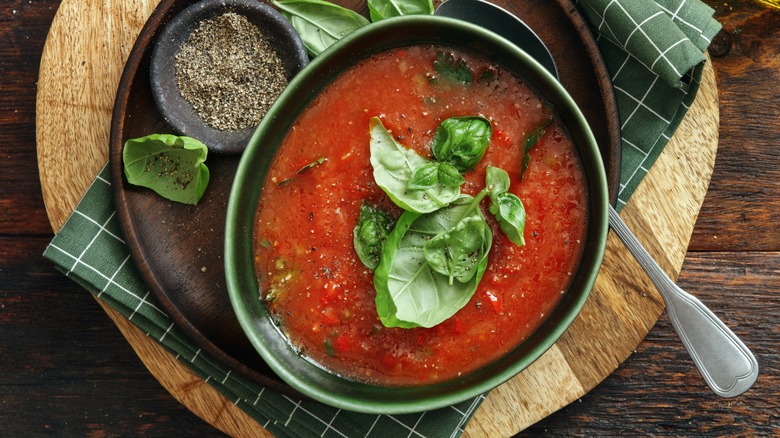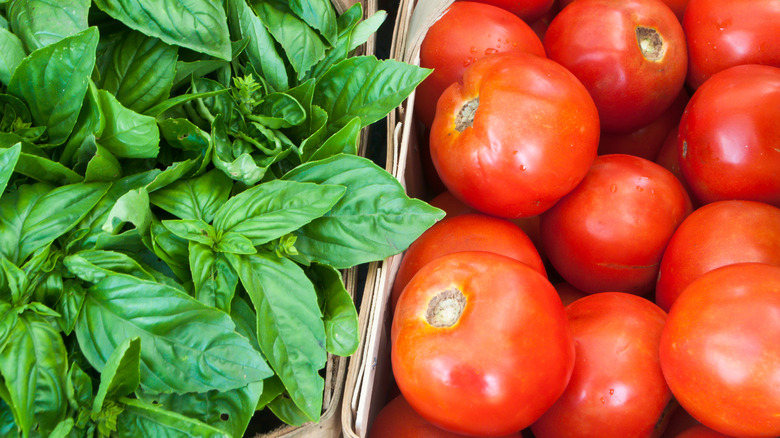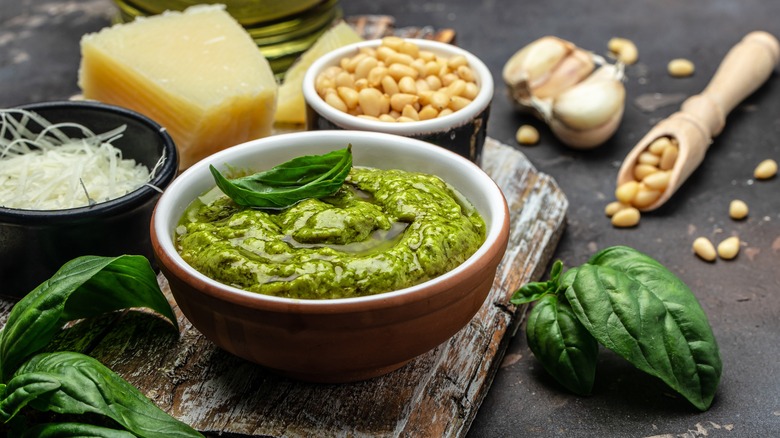A Dollop Of Pesto Is The Easy Ingredient To Effortlessly Upgrade Tomato Soup
Warm, smooth tomato soup pairs like a dream with grilled cheese, but on its own it can be a bit one-note. There are plenty of ways to doctor up a bowl of soup with add-ins, though some flavors pair more harmoniously with the acidity of a tomato base than others. Pesto, especially basil pesto, is made up of a medley of ingredients that play well with tomatoes. Basil, garlic, and parmesan all feature prominently in this sauce: a trinity of foods that often accompany tomato-heavy dishes, especially in Italian cuisine.
The fresh, herbal flavor of the basil, the nuttiness of the toasted nuts and parmesan, and the bite of the garlic all combine to add complexity and depth, evoking the flavor of a long-simmered tomato soup with a fraction of the effort. Just a spoonful of this flavor-packed sauce will transform your bowl of soup from blasé to gourmet in an instant.
Pick your pesto with care
Though premade pesto is readily available to purchase in grocery stores, not all pesto is the same. Before reaching for a jar to dollop onto your tomato soup, take some time to read the ingredients label and decide which pesto style appeals most to you.
There are plenty of variations on the classic preparation featuring pine nuts and basil. The word "pesto" itself in Italian simply "refers to anything that is crushed," according to Italian cookbook author Laura Lazzaroni. While this word, in a culinary sense, traditionally does refer to a pesto alla Genovese (the bright green and herbaceous pesto most of us are used to), riffs on this classic sauce abound.
Pesto alla Trapanese, or red pesto, for example, hails from Sicily. It features toasted almonds in place of pine nuts, as well as fresh or sun-dried tomatoes incorporated right into the sauce. Kale pesto is another popular variation, made with leafy Tuscan kale instead of basil. Some pestos substitute in less-expensive walnuts instead of pine nuts.
With such a simple recipe, these slight differences in ingredients are very noticeable in taste, and will affect your tomato soup in turn. Kale is more earthy and peppery than basil, for example, and may harmonize with the acidity of the soup in a different way. Still, though classic Genovese-style pesto pairs beautifully with tomato soup, it never hurts to experiment with other varieties as well. You might find an unlikely flavor combination that speaks to you.
Make pesto at home for added freshness
While jarred, store-bought pesto is convenient, if you want to have full control over ingredients, whipping up a batch at home is ideal. This takes more time and effort, but yields fresh and delicious results. Homemade pesto will last a few weeks in the fridge or freezer, so you'll have it on hand to add to your soup anytime.
The truly traditional way to make a simple pesto at home involves using a mortar and pestle, but if you have a food processor at your disposal, you can forgo the physical labor for a quicker, easier solution. A short blitz of all the ingredients will make the sauce come together in a snap.
If you've already got the food processor out and you want to go for a fully homemade meal, you can easily prepare your own tomato soup as well. The extra effort makes all the difference, but does sacrifice convenience. On the contrary, if you want a truly simple meal, then store-bought soup and store-bought pesto is the way to go — and it's still a winning combination. Simply mix a spoonful of pesto into your soup when warming it, taste it to check for flavor, then enjoy. An accompanying grilled cheese sandwich is, of course, optional.


